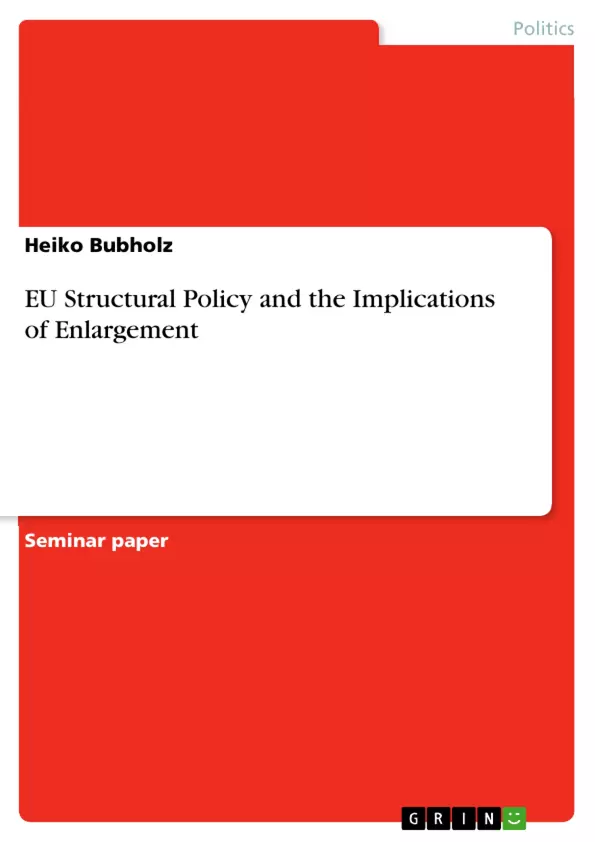After the successful and Eu(ro)phoric introduction of Europe‘s new currency – the new symbol of the Europe’s unity – emotions, especially among the Brussels technocrats, cooled down rapidly. The negotiations with the Candidate Countries entered in a new stage. Latest since the Council Meeting in Laeken the enlargement of the EU is conducted in an increasingly rational manner1. In February 2002 rumours indicated the difficulties, which the European Union faces after the enlargement.
A prominent objective of the EU is the regional cohesion, the relative regional equality, thus can hardly be accomplished in its today’s structure after the accession of up to 12 countries. The reform of the EU Agricultural and Structural Policy is inevitably today. It will need much more efforts to do so after the enlargement of the European Union. However, the agenda for enlargement is set by the political elites, not by EU bureaucracy. Thus, the negotiations may be used for a certain kind of political blackmailing within the Community. Yet, the enlargement must not fail by financial disruption, since this could easily result in dissolution of all of the European experiment2. The EU Structural Policy has been so far a more or less efficient tool to bridge the unequally distribution of wealth in the Community. It thus provided for a sustainable development and a well-balanced social climate among the Member States and its Regions. Accordingly, aim of this paper shall be first to define the term of cohesion and identify means of structural policy. The EU generated a variety of tools to accomplish its objectives in regard of “raising of the standard of living and quality of life, and economic and social cohesion” 3. Accordingly, the second part of the paper shall be devoted to describe in a limited scope the actual mechanisms of EU Structural Policy. Finally, the approaching enlargement of the Community will provoke further inconveniences concerning the Agricultural and Structural Policy. Hence, the predictable implications of the enlargement will be discussed in the last part of this paper.
[...]
Inhaltsverzeichnis (Table of Contents)
- Introduction
- Cohesion and Structural Policy
- EU Structural Policy
- Objectives
- Means of EU Structural Policy
- Agenda 2000
- Implication of EU enlargement
- Social and Economic Cohesion vs. the EU budget
- PHARE, ISPA, SAPARD, or even XYZ?
- Conclusion
Zielsetzung und Themenschwerpunkte (Objectives and Key Themes)
This paper examines the European Union's structural policy and its implications for the upcoming enlargement. It aims to define cohesion, describe the mechanisms of EU structural policy, and analyze the potential challenges and opportunities associated with expanding the EU's membership.
- Cohesion and its role in EU policy
- The mechanisms and objectives of EU structural policy
- The implications of EU enlargement on cohesion and structural policy
- The potential challenges and opportunities of expanding the EU
- The role of financial interventions in bridging regional disparities
Zusammenfassung der Kapitel (Chapter Summaries)
The first chapter introduces the concept of cohesion, distinguishing between its technical and political interpretations. It highlights the importance of promoting development in poorer regions and countries within the EU.
The second chapter delves into the intricacies of EU structural policy, outlining its objectives and the various tools employed to achieve them. It emphasizes the policy's role in fostering sustainable development and social cohesion across member states and regions.
The third chapter focuses on the upcoming enlargement of the EU and its implications for cohesion and structural policy. It explores the potential challenges posed by expanding membership, particularly in terms of balancing social and economic cohesion with the EU budget.
Schlüsselwörter (Keywords)
The key terms and concepts explored in this paper include cohesion, structural policy, regional development, EU enlargement, social and economic disparities, financial interventions, sustainable development, and the European Union's budget.
- Citar trabajo
- Heiko Bubholz (Autor), 2002, EU Structural Policy and the Implications of Enlargement, Múnich, GRIN Verlag, https://www.grin.com/document/6242



